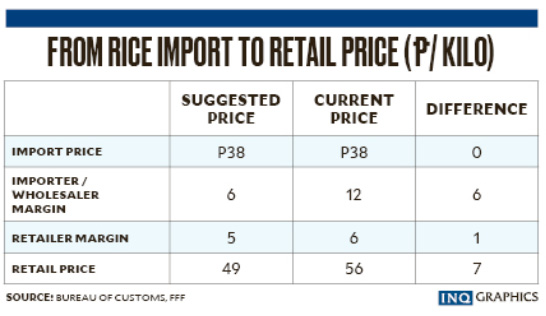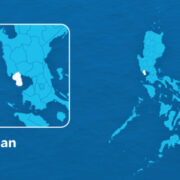How retail prices of rice may be lowered immediately

Rice retail prices can be lowered immediately if we follow the recommendation given by Representatives Nicanor Briones (Agap party list) and France Castro (ACT-Teachers party list). This is to use the suggested retail price (SRP) mechanism.
This proposal was given at a Dec. 11 hearing held by five committees at the House of Representatives “to address smuggling and price manipulation of basic goods and essential commodities.”
During this hearing, Laguna Rep. Loreto Amante wanted faster action, such as lower rice prices before Christmas. His wish can be fulfilled by using the SRP mechanism. But only if it is properly used in penalizing profiteering, as defined in the Price Act (Republic Act No. 7581).
The Price Act states: “Profiteering is the sale or offering for sale of any basic or prime commodity at a price grossly in excess of its true worth.”
Below is a table constructed with the help of Federation on Free Farmers national manager Raul Montemayor. It shows that rice profiteering is now happening on a large scale.
The import price used above is the average landed price of well-milled rice (5-percent broken), which most consumers purchase. The period covered is from last August to October. This assumes that the rice imported at that time is what is being sold today.
If the numbers above are verified by rice stakeholders in a complete supply chain, the SRP should be P49 a kilo. This is P7 lower than the current retail price of P56, indicating illegal profiteering.
But if we later use the current lower import price of P33 instead of the former P38 price, once the older stocks are sold, the SRP would then be P44 a kilo. Filipino consumers are currently getting an unfairly high price.
At the same time, because of the decreased 15-percent tariff, local farmers have suffered an 8-percent decrease in their incomes. At least P7 billion in foregone tariff revenue that they should have gotten has also been lost.
Proven steps. Two steps taken during the Ramos Administration that successfully decreased high rice prices must now be taken. The first step is to implement the Price Tag Law (or Consumer Act aka RA 7594—ed), which mandates that all products should display price tags.
Also, the Price Act states that illegal profiteering occurs “whenever a basic necessity or prime commodity being sold has no price tag.”
In implementing this law (Price Tag Act), all outlets that had no rice price tags were automatically closed. Since this was a violation of a law, business permits were suspended, until the price tags were displayed. Though usually for only one day, wide media coverage resulted in quick widespread price tag implementation. Consumers could now compare prices, and excessive prices immediately identified for profiteering charges.
The second step is for the Department of Agriculture (DA) to decide on the correct SRP. Today, there is no SRP for well-milled rice. The Department of Trade and Industry initiated this SRP practice during the Ramos administration.
All players in the supply chain are called to a meeting to discuss costs and reasonable margins. They include producers, importers, wholesalers, retailers, and consumers. With the guidance, an SRP is decided for the government to implement.
There was a time when the DA decided on an SRP without this consultation. The SRP was so low, that the supply vanished. Thankfully, this was soon corrected.
Not price control. Price control is usually counterproductive. This is because it sets a price level that all must follow, despite their differing circumstances. The SRP is instead used only as a guide to determine whether there is profiteering or not.
For example, if the retail outlet is far from the product source, a price higher than the SRP is allowed. But if the price unreasonably exceeds the SRP, the retail outlet is immediately penalized for profiteering.
The SRP has two advantages. First, it informs the consumer of the reasonable product price. Second, it warns the retailer of stiff penalties for profiteering. Consequently, the retailer thinks twice before he posts a profiteering price. Again, consequently, general price levels go down.
The SRP mechanism identified in the last Congressional hearing must be implemented immediately. If executed properly, Amante’s wish for decreased rice prices before Christmas will certainly become a reality.
The author is Agriwatch chair, former secretary of presidential flagship programs and projects, and former undersecretary of the Department of Agriculture and the Department of Trade and Industry. Contact is agriwatch_phil@yahoo.com.





















